
The Lie of Scarcity and the Monster of Competitiveness
Twelve years ago, I was just entering the world of online writing. It was crowded (blogs were barely hanging on) but not quite oversaturated.
The next decade, I watched an awkward evolution. The blogosphere went from hobby-writing and silly storytelling to platforming, branding, and networking. Writers became content creators and the market was suddenly bursting at the seams with words. Everybody had some.
I became paralyzed, afraid to add to the noise that already felt so loud (and frankly, better than my own). And I quickly realized that my ability to compare myself with other writers was just way too easy, way too measurable—I mean, likes and followers were basically votes for who people liked more, whose words were best.
And a question hung over my head every time I pressed publish: “Am I good enough to be here?”
When I started working for Rebecca two years ago, I noticed that this struggle is one designers are knee-deep in as well.
Inundated with other designers’ beautiful work and following, mountaintop moments, photoshopped images and accolades, gorgeous before-and-afters, the same question starts to hover over them: “Am I good enough to be here?”
And as the self-doubt starts to really assert itself, another monster tends to rise up to challenge it, a coping mechanism of sorts.
Competitiveness.
Now here’s the tricky part. A competitive nature can be a really positive thing. In healthy doses, it can motivate and spark creativity, bringing out the very best in us.
But if we aren’t careful, competitiveness begins to breed negativity.
The design world is made up of individuals who bring completely different perspectives to the projects they design. It can be tempting to look at someone else's unique-to-them work with an eye of criticism and comparison rather than appreciation: “That kitchen is too modern and cold,” “The paint colors they used in that space are too aggressive,” “That style feels so old-fashioned.”
I’ve done it. Because at the end of the day, I just wanted to convince myself that I was good enough. And maybe, if I was better than just one person, that meant I actually belonged.
The lie of scarcity—it starts in middle school with the economics of friendships. There’s only so much to go around so you better GET YOURS. Claim your status, your rank, your place. Prove your worth by proving you’re better. Because if not, there’s no room for you.
But scarcity is a lie. There’s enough. Enough friendship, enough air, enough success, enough belonging, enough space, enough people looking for help with their homes, enough room for your perspective (because you are literally the only one with it.)
Instead, make room. Open doors. Reach out. Be generous with your resources, your gifts, your compliments. A scarcity mindset breeds fear and isolation, while a generous mindset creates community because more often than not, we realize the truth of our belonging through the confidence of others—that moment someone turns around and says, “You’re good. Let me help you.”
The very thing that makes us unique, the fact that I would design something differently than you, is a GOOD thing—not something to be criticized but something to be celebrated. There is more than one way to curate beauty and how cool that we get to watch each other make those choices.
So, the next time competitiveness tries to convince you you’re not good enough unless you’re better than them, remind your brain there’s room for you both: both of your skill sets, both of your perspectives, both of your success. There’s especially room for learning—even from one another.
